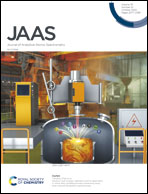Synchrotron micro-XRD and micro-XRD-CT reveal newly formed lead–sulfur compounds in Old Master paintings†
Abstract
The in situ formation of lead–sulfur inorganic compounds in historical oil paintings can have a strong detrimental effect on an artwork's physical and visual integrity. In this paper, paint micro-samples collected from several paintings from the Rijksmuseum (Amsterdam) and Mauritshuis (The Hague) collections were probed using a combination of synchrotron micro-XRD and micro-XRD-CT. This permitted precise identification of the chemical nature of the in situ formed crystalline compounds as well as charting their distribution within paint layers at the microscopic level. This provided new information on the origin of the ions involved in the crystallization of the various newly formed mineral lead–sulfur products. The formation of palmierite K2Pb(SO4)2, anglesite PbSO4 and lanarkite Pb2(SO4)O in historical samples can thus be connected to the paint stratigraphic build-up, environmental conditions and potential past restoration treatments.



 Please wait while we load your content...
Please wait while we load your content...